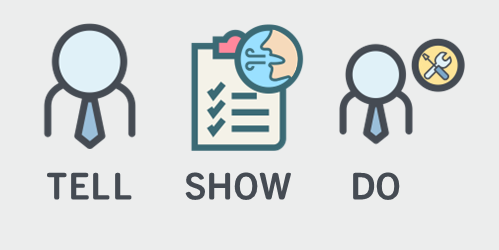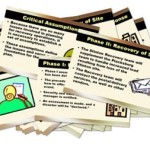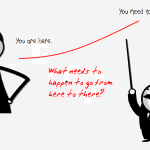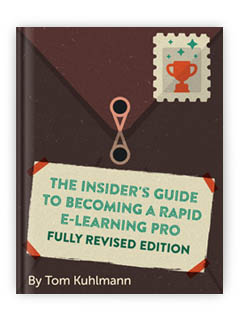Hi Tom,
I love and use the tell, show, and do model. I also add an exploration portion before the model to help attain background knowledge. I encourage you to check out Martin Haberman’s pedagogy about why it is important to add exploration for inner-city students.

From an ideal perspective, when we build courses, we’re trying to change performance and not just share a bunch of information. That means we need a course design model that goes beyond content-sharing. One common approach for online course design is the Tell, Show, and Do model.
It makes sense because it’s simple, covers the basics, and steers us towards the course’s performance expectations.
Tell People What They Need to Know
What do they need to know and why?
The goal is to establish expectations and clarity around objectives. This helps create a framework for learning. It also establishes context. Instructionally, “telling” allows us to curate content, package, and present it in a manner that saves time compared to self-discovery (which is in its own way an effective strategy).
Show People What They’re Supposed to Do
Knowing and doing aren’t the same. The next step in the process is to move beyond content and towards application. What are they to do with all of the content you shared? Avoid showing what happens if they do something wrong and instead focus on the positive action.
Document the process, steps required, and where to find the content to make the decisions they need to make.
Do the Activity to Practice What They Need to Do
Unfortunately, most e-learning stops at the Telling and Showing part of the process. As a younger instructional designer, I learned that the instructor does the telling and showing and the learner does the doing. If the end goal is for the learner to do something specific (and measurable) then the training needs to integrate the activity and decision-making required to do what’s learned.
Build into the course the application of what’s learned so that the learner can practice and get feedback, and ultimately demonstrate understanding. Keep in mind that not all of those types of activities can be built into the e-learning course. In those cases, design some sort of offline learning component where the learner can do the “doing.”
The Tell, Show, and Do model is a simple and common instructional technique because it lets you build context and demonstrate the desired performance while the learner gets to practice applying what they learned. In addition, by focusing on the “doing” it moves your course design away from the all too familiar linear, click and read model.
Events
- Everyday. Check out the weekly training webinars to learn more about Rise, Storyline, and instructional design.
Free E-Learning Resources
 |
 |
 |
|
Want to learn more? Check out these articles and free resources in the community. |
Here’s a great job board for e-learning, instructional design, and training jobs |
Participate in the weekly e-learning challenges to sharpen your skills |
 |
 |
 |
|
Get your free PowerPoint templates and free graphics & stock images. |
Lots of cool e-learning examples to check out and find inspiration. |
Getting Started? This e-learning 101 series and the free e-books will help. |









0
comments